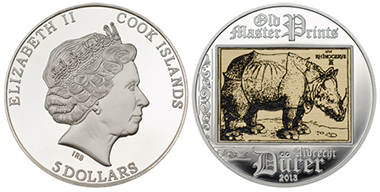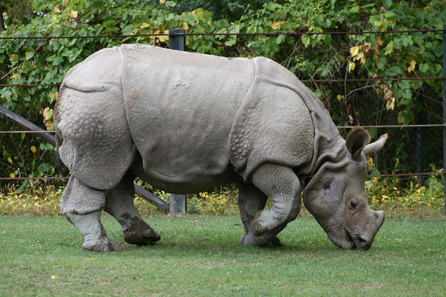July 4, 2013 – Coin Invest Trust has developed another outstanding stamping for the Cook Islands. A new coin celebrates Albrecht Dürer’s legendary woodcut ‘Rhinoceros’, a print of which was recently auctioned for a record sum. The coin harks back to the age of copperplate engraving, with the silver coin featuring a copper inlay of the Indian rhinoceros.
Cook Islands / 5 Dollars / Silver 925 / 20 g / 38.61 mm / Mintage: 2,500.
The front of the coin features the portrait and name of the Cook Islands’ Head of State, Queen Elizabeth II. The name of the issuing country, Cook Islands, and the nominal value, 5 dollars, appear along the rim.
On the coin’s reverse, an etched copper inlay of Dürer’s ‘Rhinoceros’ appears within a rectangular box. Above it, in German type, are the words Old Master Prints, and below it, Albrecht Dürer and the year of issue, 2013. Floral elements are engraved on the side.
Indian rhino in the Metro Zoo Toronto. Photo: Darren Swim / http://creativecommons.org/licenses/by-sa/3.0/deed.en
On May 20, 1515, for the first time since antiquity, a live Indian rhinoceros arrived in Europe. The animal had arrived via the sea route newly discovered by the Portuguese, the same route that Columbus had searched for and yet, despite all his success, did not find. The animal created quite the stir in the Portuguese Royal Court. At the end of the year, however, King Manuel I decided to send the rhino as a gift to Pope Leo X. The rhinoceros travelled by sea via Marseille to Italy, but the ship sank off the Ligurian coast. The securely shackled animal drowned, and only its hide was salvaged and then returned to Lisbon. There, it was skillfully mounted and then shipped to Rome once more. What became of the preserved specimen after that is not known, but thanks to Albrecht Dürer of Nuremberg, one of the most important artists of his time, the Indian rhinoceros achieved immortality. An acquaintance of Dürer, who had seen the Indian rhinoceros in Lisbon, described the animal to him in a letter and also included a small sketch. Dürer, who had never set eyes on the exotic creature himself, created drawings that included certain details that were anatomically incorrect when compared to the actual, living creature, such as the second horn on the back and the armour-like plate elements of the skin.
Rhinocerus by Albrecht Dürer, 1515. Source: Wikipedia.
Dürer decided to have the drawings printed. In order to keep printing costs low he opted against the copperplate engraving technique and chose a cheaper woodcut. It was this decision that very well led to the constant reprinting and extremely rapid and wide dissemination of the work. Dürer’s depiction of the animal shaped the European image of an Indian rhinoceros right up to the mid 18th century, when another specimen arrived in Europe. Consequently, the historical impact of the woodcut was enormous. A print of the first version from 1515 was auctioned at Christie’s in New York in January 2013 for the amazing sum of 866,500 dollars, and attests to the work’s enduring appeal.
Whereas cost considerations led Dürer to opt for the woodcut over copperplate engraving, Coin Invest Trust has now reproduced his rhinoceros on a silver coin using that very same sophisticated copperplate engraving technique.
The coin was minted by Faude & Huguenin, Le Locle (Switzerland).
You can find more information on this coin on the website of Coin Invest Trust.
More than 3,000 works of Dürer are made available on the website Bildindex der Kunst und Architektur.
About the record price at Christie’s you can read an article here.







